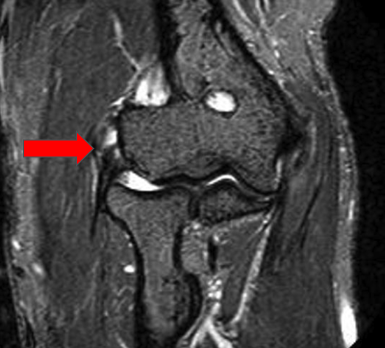Lateral Elbow Musculotendinous Injury & Tendinopathy
1/33
There's no tags or description
Looks like no tags are added yet.
Name | Mastery | Learn | Test | Matching | Spaced |
|---|
No study sessions yet.
34 Terms
Lateral Epicondylitis/Epicondylalgia
Tendinosis/itis/opathy of the common extensor tendon aka
Tennis Elbow
Lateral Elbow Pain AKA Lateral Epicondylalgia or Tennis Elbow is the
most common chronic condition affecting the elbow
Lateral Elbow Pain incidence and prevalence
Lifetime incidence of 40%
Prevalence of 1.3%
Lateral Elbow Tendinopathy of the common extensor tendon can present
w/ & w/o inflammatory cytokines (substance P)
what is the most common tendon involved in lateral epicondylitis?
Extensor carpi radialis brevis
Risk Factors for Lateral Elbow Pain
Females>males
35-54 y/o
UE athletes: 50% tennis players
Manual laborers: 17%
Other: Low levels of social support, Office Work (repetitive micromvmts), Concurrent shoulder pathology, Tobacco use
Lateral Epicondylalgia Clinical Course/Natural History
6 months to 2 years
50% report not being recovered at 12 months
20% reported ongoing sxs for 3-5 yrs
High baseline severity ↑ risk of chronic sxs
Lateral Elbow Epicondylalgia Presentation is Lateral Elbow pain that can radiate into dorsal forearm, most commonly in the dominant arm. Point tenderness found over the lateral humerus: 1cm distal to lateral epicondyle. Signs & sxs include
Painful gripping (grip w/ wrist ext for optimal LTR)
Pain w/ passive stretching (wrist flexion): Elbow ext > Flexion
Pain w/ active wrist ext: Elbow ext > Flexion
Dull or sharp pains: Rest should be pain free or reduce sxs
Lateral Elbow Pain Differential Diagnosis**
-Cervical radiculopathy C6-7 (insidious)
-Radial Tunnel Syndrome (also supinator entrapment, if pain more distal more likely RTS)
-PLRI (trauma hx)
-Posterior IO Syndrome: Muscle weakness of finger & thumb extensors
-Intra-articular Disease
Lateral Elbow Pain/Epicondylalgia Etiology is an overload of common extensor tendon due to
Repetitive gripping
Insidious onset w/out specific event
Lateral Elbow Pain/Epicondylalgia Etiology: if a Tendinitis progresses to a Tendinosis, inflammatory markers
are not always present
Tendinopathy Theories: Overload, Vascular (angiogenesis), Neural

Ultrasound Imaging & MRI for Lateral Elbow Pain/Epicondylalgia can show
Focal hypoechoic regions
Tendon thickening
Neovascularization
Intrasubstance tears (→)
50% of age matched controls demonstrate musculotendinous changes of lateral elbow, which means imaging is
sensitive to detecting presence of Lateral Epicondylalgia, Not specific
Lateral Elbow Pain/Epicondylalgia impairments include
Central pain processing changes: Central Sensitization → Hyperalgesia
↑ Cervical Thoracic impairments: Pain & limited ROM, Adverse neural dynamics
Load intolerance of extensor musculature: Pain free grip ↓ by 43-64%
Weakness of entire UE
Lateral Elbow Pain/Epicondylalgia Special Tests
Radial Bias Neurodynamic Assessment
Cozen’s Test
Grip Strength & Pain free griping
Mill’s Test
3rd Finger Resistance Test
Palpation
Lateral Elbow Pain/Epicondylalgia Management includes
Load management: activity modification
Progressive exercise to focus on improving load tolerance: eccentric vs isotonic may not matter. Pain should subside w/in 24hrs to progress.
MT for pain modulation
Wrist/Hand Orthosis
Counter force bracing
Injections
Lateral Epicondylalgia Load Management education should include a
natural history of the dx, may take some time
Prolonged recovery
Lateral Epicondylalgia Load Management/Activity modification
Change in gripping: Supinated better than pronated
Racquets or club positioning (forward hand better)
Maybe fat grips
Changes in job related tasks
Job reassignment
Changes in exercise or work volume
Lateral Epicondyle exercise has shown to be superior to passive treatments alone. These exercises include
Stretching & Isometric: Highly reactive/irritable
Isotonic exercise
Eccentric exercise: Lower reactivity/lower irritability
Painful loading
Exercise for entire UE: Don’t only focus on extensor tendons

Wrist/Elbow Manual Therapy for lateral epicondylalgia (Board mwm)
Mill’s Manipulation
MWM: Pain free griping (sustained glide 3×10 squeezes)
Friction Massage
Cervical Thoracic MT for lateral epicondylalgia improves Cervical Thoracic pain & ROM; for lateral epicondylalgia it ↑
pain Pressure Threshold at the lateral epicondyle
Neurodynamic Interventions for Lateral Epicondylalgia w/ mixed presentation in order to decrease
neural sensitivity (change way pain is conducted)
Orthosis & Taping for lateral epicondylalgia
Wrist orthosis (into optimal gripping position)
Counterforce Brace: Not superior to exercise, = to CSI in short term
taping: limited evidence
lateral epicondylalgia Low Risk Group factors:
Lower perceived disability
High control of painful tasks or jobs
Lower overall pain severity
Lateral epicondylalgia Low Risk Group Interventions:
Activity Modification
Oral medication for pain
Modalities
Wait & see
lateral epicondylalgia Moderate Group Factors:
Mod perceived disability
Lower job control: Repetitive higher loading
Mod levels of pain & irritability
Greater MSK impairments
Interventions for those in the moderate irritability group of Lateral epicondylalgia:
Activity Modification
Oral medication for pain
Modalities
Active management: MT, Exercise: Isotonics → eccentrics
Lateral Epicondylalgia High Risk Group Factors:
High perceived disability
no control of painful tasks or jobs
High overall pain severity & irritability
Comorbid neck & shoulder pain
Signs of central sensitization
Lateral epicondylalgia High Risk Group Interventions:
Activity Modification
Oral meds for pain
Modalities
Regional MT
Regional UE exercise: Isometrics → isotonics
Corticosteroid Injection (CSI) Therapy for later epicondylalgia has
Short term improvements in pain
Limited effect on function
Long term pts who received CSI may be worse off than those who did not
PRP Injections for lateral epicondylalgia
Try this before corticosteroid inj
Not superior to placebo (Saline): Simental-Mendia 2020 SR/MA
Long term PRP > CSI: Natural hx
Indications for lateral epicondylalgia Surgical Intervention
Failure to respond to extensive conservative mgmt
Failure to respond to injections
Substantial imaging findings: RCL tear &/or CET tear
Lateral Epicondylalgia Surgical Intervention procedures
Extensor Carpi Brevis debridement, repair or release
RCL repair/reconstruction
Lateral epicondylalgia surgical Intervention Outcomes have
limited evidence & mixed outcomes: good outcomes in recalcitrant cases